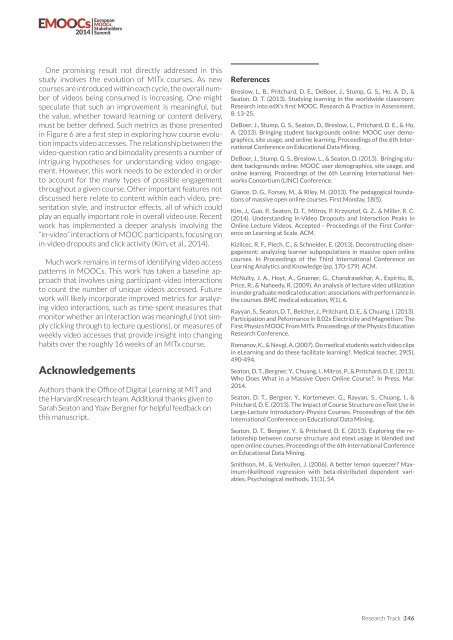zmWmQs
zmWmQs
zmWmQs
Create successful ePaper yourself
Turn your PDF publications into a flip-book with our unique Google optimized e-Paper software.
One promising result not directly addressed in this<br />
study involves the evolution of MITx courses. As new<br />
courses are introduced within each cycle, the overall number<br />
of videos being consumed is increasing. One might<br />
speculate that such an improvement is meaningful, but<br />
the value, whether toward learning or content delivery,<br />
must be better defined. Such metrics as those presented<br />
in Figure 6 are a first step in exploring how course evolution<br />
impacts video accesses. The relationship between the<br />
video-question ratio and bimodality presents a number of<br />
intriguing hypotheses for understanding video engagement.<br />
However, this work needs to be extended in order<br />
to account for the many types of possible engagement<br />
throughout a given course. Other important features not<br />
discussed here relate to content within each video, presentation<br />
style, and instructor effects, all of which could<br />
play an equally important role in overall video use. Recent<br />
work has implemented a deeper analysis involving the<br />
“in-video” interactions of MOOC participants, focusing on<br />
in-video dropouts and click activity (Kim, et al., 2014).<br />
Much work remains in terms of identifying video access<br />
patterns in MOOCs. This work has taken a baseline approach<br />
that involves using participant-video interactions<br />
to count the number of unique videos accessed. Future<br />
work will likely incorporate improved metrics for analyzing<br />
video interactions, such as time-spent measures that<br />
monitor whether an interaction was meaningful (not simply<br />
clicking through to lecture questions), or measures of<br />
weekly video accesses that provide insight into changing<br />
habits over the roughly 16 weeks of an MITx course.<br />
Acknowledgements<br />
Authors thank the Office of Digital Learning at MIT and<br />
the HarvardX research team. Additional thanks given to<br />
Sarah Seaton and Yoav Bergner for helpful feedback on<br />
this manuscript.<br />
References<br />
Breslow, L. B., Pritchard, D. E., DeBoer, J., Stump, G. S., Ho, A. D., &<br />
Seaton, D. T. (2013). Studying learning in the worldwide classroom:<br />
Research into edX’s first MOOC. Research & Practice in Assessment,<br />
8, 13-25.<br />
DeBoer, J., Stump, G. S., Seaton, D., Breslow, L., Pritchard, D. E., & Ho,<br />
A. (2013). Bringing student backgrounds online: MOOC user demographics,<br />
site usage, and online learning. Proceedings of the 6th International<br />
Conference on Educational Data Mining.<br />
DeBoer, J., Stump, G. S., Breslow, L., & Seaton, D. (2013). Bringing student<br />
backgrounds online: MOOC user demographics, site usage, and<br />
online learning. Proceedings of the 6th Learning International Networks<br />
Consortium (LINC) Conference.<br />
Glance, D. G., Forsey, M., & Riley, M. (2013). The pedagogical foundations<br />
of massive open online courses. First Monday, 18(5).<br />
Kim, J., Guo, P., Seaton, D. T., Mitros, P. Krzysztof, G. Z., & Miller, R. C.<br />
(2014). Understanding In-Video Dropouts and Interaction Peaks in<br />
Online Lecture Videos. Accepted - Proceedings of the First Conference<br />
on Learning at Scale. ACM.<br />
Kizilcec, R. F., Piech, C., & Schneider, E. (2013). Deconstructing disengagement:<br />
analyzing learner subpopulations in massive open online<br />
courses. In Proceedings of the Third International Conference on<br />
Learning Analytics and Knowledge (pp. 170-179). ACM.<br />
McNulty, J. A., Hoyt, A., Gruener, G., Chandrasekhar, A., Espiritu, B.,<br />
Price, R., & Naheedy, R. (2009). An analysis of lecture video utilization<br />
in undergraduate medical education: associations with performance in<br />
the courses. BMC medical education, 9(1), 6.<br />
Rayyan, S., Seaton, D. T., Belcher, J., Pritchard, D. E., & Chuang, I. (2013).<br />
Participation and Peformance in 8.02x Electricity and Magnetism: The<br />
First Physics MOOC From MITx. Proceedings of the Physics Education<br />
Research Conference.<br />
Romanov, K., & Nevgi, A. (2007). Do medical students watch video clips<br />
in eLearning and do these facilitate learning. Medical teacher, 29(5),<br />
490-494.<br />
Seaton, D. T., Bergner, Y., Chuang, I., Mitros, P., & Pritchard, D. E. (2013).<br />
Who Does What in a Massive Open Online Course. In Press, Mar.<br />
2014.<br />
Seaton, D. T., Bergner, Y., Kortemeyer, G., Rayyan, S., Chuang, I., &<br />
Pritchard, D. E. (2013). The Impact of Course Structure on eText Use in<br />
Large-Lecture Introductory-Physics Courses. Proceedings of the 6th<br />
International Conference on Educational Data Mining.<br />
Seaton, D. T., Bergner, Y., & Pritchard, D. E. (2013). Exploring the relationship<br />
between course structure and etext usage in blended and<br />
open online courses. Proceedings of the 6th International Conference<br />
on Educational Data Mining.<br />
Smithson, M., & Verkuilen, J. (2006). A better lemon squeezer Maximum-likelihood<br />
regression with beta-distributed dependent variables.<br />
Psychological methods, 11(1), 54.<br />
Research Track | 146


